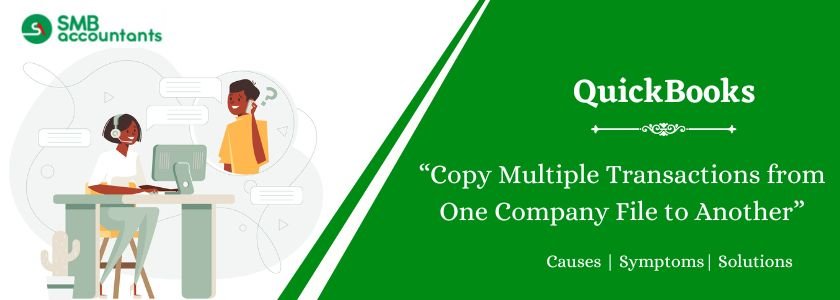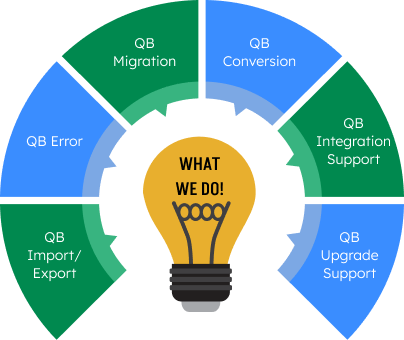The article will explain the steps to Copy Multiple Transactions from One Company File to Another. Walk through the information to save your time:
Table of Contents
- 1 How to Copy Multiple Transactions from One Company File to Another?
- 2 Copying Information From One Company File to the Other One
- 3 Frequently Asked Questions
- 3.1 Q 1: How can I create a copy of an existing company file in QuickBooks?
- 3.2 Q 2: How can I delete the transactions from the copied company file in QuickBooks?
- 3.3 Q 3: How to check the status of the transaction in the accounts?
- 3.4 Q 4: How do you copy and paste batch transactions in QuickBooks desktop?
- 3.5 Q 5: Is there a way to merge two QuickBooks files?
- 4 Adams Williams
How to Copy Multiple Transactions from One Company File to Another?
The solutions we are going to provide will work for QuickBooks 2018 or other newer versions (Premier Accountant Edition or Enterprise Accountant Edition) of transactions given below:
- Cheques
- Credits and Credit Card charges
- Deposits
- Credit and Invoice Memos
- Bill Credits and Bill
Make sure that you try this process on the accountant’s copy if the transaction date is before the dividing date.
Step 1: Preferences Should be set appropriately in order to allow export
- Disabling the Account Number’s use
- Go to the Edit menu and then click on Preferences
- Choose Accounting and then tap on the tab of Company Preferences
- Make sure that the checkmark is removed from Use account numbers, and then click on OK
- Disabling the Sales Tax
- Go to the Edit menu and then click on Preferences
- Choose Sales Tax and tap on the tab of Company Preferences
- Now in the section of Do, you charge sales tax, select No and then click on OK
Read more: How to Run a Transactions by Account Report in QuickBooks Desktop
Step 2: Creating the report of Custom Transaction Detail
- Go to the Reports menu and then select Custom Reports after that tap on the Transaction Detail
- Click on the Customize Reports and then make the modifications in the report as given below:
- Select desired date
- In Transaction Type, choose the transaction type which you want to keep
- In Detail Level choose all except summary
- Then choose the columns based upon the transaction type:
- Cheques/Checks
- Cheque Number
- Date
- Name of the Payee
- Debit Amount
- Memo
- Account
- Deposits
- Name
- Date
- Account
- Cheque Number
- Memo
- Credit Amount
- Credit Card Charges and Credits
- Date
- Name (Payee)
- Account
- Debit (Amount)
- Memo
- Bills and Bill Credits
- Date
- Num (Ref No.)
- Name (Vendor)
- Terms
- Debit (Amount)
- Item Description
- Invoices and Credit Memos
- Date
- Number
- Name (Customer:Job)
- Terms
- Debit (Amount)
- Item Description (Description)
- Item
- Qty
- Sales Price (Rate)
- Amount (Total)
- In order to run the report, click on OK
- Make sure that report is memorized for you and you can also save it in the form of a PDF.
Read more: How to Delete Multiple Transactions in QuickBooks
Step 3: Exporting the Report to The Excel
- Keep the report open and then click on the drop-down of Excel
- Choose to Create New Worksheet
- Then choose in a new workbook and then tap on Export
Step 4: Enter Transactions into the New Company file using the Batch Enter Transactions Screen.
Note: As long as the transaction dates are before the division date, this process will work in an Accountant’s Copy
Get Expert Advice to Fix All Accounting & Bookkeeping Problems

Copying Information From One Company File to the Other One
To copy information from one file to another:
- Go to the current data file and then tap on File and then Utilities after that on Lists. Choose the lists that you are willing to be copied on the New Data File, keeping the Chart of Account’s exception in mind, will work on it in the next step. Then select the place where you want to save the file and also add the name of the file by applying the extension of IIF.
- In your current data file, tap on File, and then from the existing company file that is existing, choose New Company. After typing the New Company Name, click on Create Company. By doing this, the Chart of Accounts will be copied, excluding data in the New Data file. The data accounts could be deleted only at this time, so make sure the changes that you are willing to make are done at this stage.
- After that get the New Data File opened and then click on the File then on Utilities then on Import and after that on IIF files. The list which was exported by you will get copied without the balances. You can easily manage your data at this stage, by deleting the items, vendors, and customers that you do not need any longer.
- Here, you have to get the information of the New Company entered here, for example, Business number, etc. now in the setup, you can get the opening balances added. Remember not to enter the opening balances in the Accounts Payable and Accounts Receivable. To create balances, make sure that Vendor Bills and Customer Invoices are created in the New Company only.
QB Issue Resolution:
In order to do this, you must meet the following criteria:
- The actions encompass checks, deposits, charges from credit cards, or credit card refunds. (For QuickBooks 2018, you additionally have the option to include invoices, credit entries, bills, and bill credits.)
- You’ll be importing this data into QuickBooks versions from 2018 or later, specifically the Accountant’s Edition or Enterprise Accountant ONLY.
Need Professional Help?
If you are facing such issues/questions or any other situation like this, then without being hesitant, get in touch with the SMB QuickBooks technical support team. You can easily get in touch with the SMB QuickBooks tech support helpdesk on smbaccountants.com.
Frequently Asked Questions
Q 1: How can I create a copy of an existing company file in QuickBooks?
Ans: Below are the steps:
- Now you have copies of the company file
- Open your QuickBooks Desktop & company file you need to copy
- Hit on the F2 button to display the product information window
- Locate the file info part to know the information related to the company file
- Use the backup file to restore the company file.
- Now rename the file you get after restoring the file.
- It will generate a unique copy of the genuine company file.
- Now save the new file.
Q 2: How can I delete the transactions from the copied company file in QuickBooks?
Ans: Below are the steps:
- Open the new company files.
- Verify it.
- Locate the file option and then hit on Utilities.
- Choose to Condense data.
- Click on the yes option if you get a message about removing data.
- Choose All transactions in the condensed Data window.
- Hit on the Next button.
- Follow the instructions displayed on the screen to delete the copied transactions.
Q 3: How to check the status of the transaction in the accounts?
Ans: Below are the steps:
- Locate Reports option.
- Hit on Reports center.
- Discover the Account & Taxes button.
- Now open a transaction list through the Date report.
- Set the date range for the report so that it begins before the past transaction in the file you copied.
Q 4: How do you copy and paste batch transactions in QuickBooks desktop?
Ans: To emphasize information, simply click on it, then right-click and select the “Copy” option. Next, in the Batch Enter Transaction window, right-click the first date field and click “Paste.” It is important to note that if details are not currently listed in the company file they will be highlighted in red. If you find red-highlighted details, select them and choose “Quick Add” or “Set up.”
Q 5: Is there a way to merge two QuickBooks files?
Ans: Go to the QuickBooks Reports menu and choose “Combine Reports from Multiple Companies.” Click on “Add Files,” find the other company file, and click “Open.” Repeat this process for any additional files. In the “Select reports for combining” section, pick the reports you wish to merge.

Adams Williams
Adams Williams is a seasoned accounting professional with over 4 years of experience in bookkeeping, financial reporting, and business accounting solutions. Specializing in QuickBooks software, Adams combines technical expertise with clear, accessible content writing to help businesses streamline their financial processes. His insightful guides and how-to articles are crafted to assist both beginners and seasoned users in navigating accounting software with confidence.



